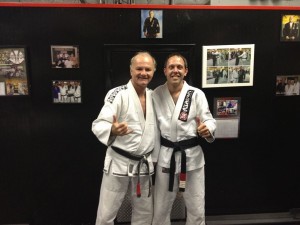Aaron Lapointe, Carlson Gracie Black Belt
Last year I wrote an article on my one-armed approach to jiu-jitsu. In that article I talked about my guard work, sweeps, and fundamentals. At the end of that article I promised to write a follow-up with an emphasis on takedowns, pins, and submissions. Sorry it took me so long to respond.
Takedowns
The first jiu-jitsu tournament I ever entered as a white belt I tried to stand with my opponent. Within 30 seconds my opponent threw me flat on my back with an osoto-gari (i.e., major outside reap). After that loss I decided to “pull guard” whenever possible. Although this became an effective strategy for me in competition, I never lost sight of the fact that it was very important to know how to take someone down. Over the years, and with lots of guidance, I learned that a low-single leg could be successfully applied with one arm, particularly from the clinch. Grabbing around the outside of my partner’s leg, I pin my same-side shoulder and head up against the leg before sliding it down past the knee. In order to get low on the leg and increase my pushing power I drop my outside knee to the ground while pushing off with my other foot. I then lower my hand and cup my partner’s heel to limit his or her mobility. When done correctly this movement straightens (i.e., hyper-extends) my partner’s leg and forces him or her to fall back. If the person’s other foot is close by I sometimes reach across and grab it by the ankle while continuing to driving forward with my shoulder. Be careful if you try this move because it can put a lot of strain on your partner’s knee.
Despite practicing my takedowns on occasion, I never had the confidence or skill to use them in competition until I started training judo. Three years ago I joined a judo club and instantly fell in love with the sport. Although the major throws in judo like seoi-nage and uchi-mata are difficult, but not impossible, to execute with one arm (see footage of Toshihiko Koga), I have had great success with the foot throwing techniques, particularly ouchi-gari, kouchi-gari, and deash-harai. Timing is critical with these throws since kazushi (i.e., the breaking of balance) is often difficult with one arm. Despite the many challenges that judo has presented, I am confident that a one-arm practitioner could become very proficient at takedowns with the proper mindset and training.
Submissions
My submission game is really no different than most peoples in that I use a variety of chokes and joint locks. For the most part, my setups have to be pretty tight in order for me to secure the submission. Consequently, I often use my legs and hips to minimize my partner’s escape route. Not surprisingly, the triangle was the first submission I had regular success with in sparring and competition. Once I learned that I could trap my partner’s extended arm by lifting my hips high off the ground and rotating my body, my triangle became very effective. After I started applying this principal to the basic armbar from the guard, I saw how important my legs and hips were in setting up my submissions. In fact, sometimes my lower body does 90% of the work. With regard to chokes and strangulations, I’ve discovered that there are a lot of ways I can finish the submission once I get one hand deep in the collar. I just have to figure out how to apply the right pressure and restrict my partner’s movements. Oftentimes this requires using a different part of my body (e.g., leg, shoulder) in place of my second hand. Another submission that I’ve become very adept at over the years is the straight ankle/achilles lock. In order to secure this lock I sometimes grab my lapel with my hand once I’ve wrapped around the ankle.
Pinning
Generally speaking, whenever I try and control somebody I have to be conscious of what my bad arm, the one I can’t use, isn’t doing. For example, if I pass to one side and control the person’s upper body with my good arm, I need to be cognizant of the fact that I don’t have a second hand to control the person’s hips and same side leg. Consequently, I often use my knee to fill that void or keep my hips low and/or away at an angle to prevent the person from recomposing guard. If my goal is to hold the person down and prevent him or her from moving, I often transition to a modified scarf hold (i.e., good arm over my partner’s face, looking at his or her feet). Not only does this pin make it difficult for the person to recompose (i.e., my knee is blocking the hips), but is also allows me to quickly transition to mount by throwing my leg over or sliding my knee/shin across the stomach. When I do get the mount I have to be very conscious of the fact that I can be easily rolled to my bad side if I don’t adjust my weight properly. Since I’ve started training judo I’ve also become quite proficient at using kesa gatame to hold my partner down. I just have to make sure my left knee is positioned under my partner’s shoulder so he or she can’t pull the arm out or take my back. One thing I like about kesa-gatame is the quick transition to kata-gatame (i.e., shoulder hold) that is often available.
That concludes Part 2 of this article. Thank you for reading. Below is a match of mine from the 2000 BJJ Pan American Championships. Feel free to contact me at aaronlapoi@yahoo.com with any questions.
